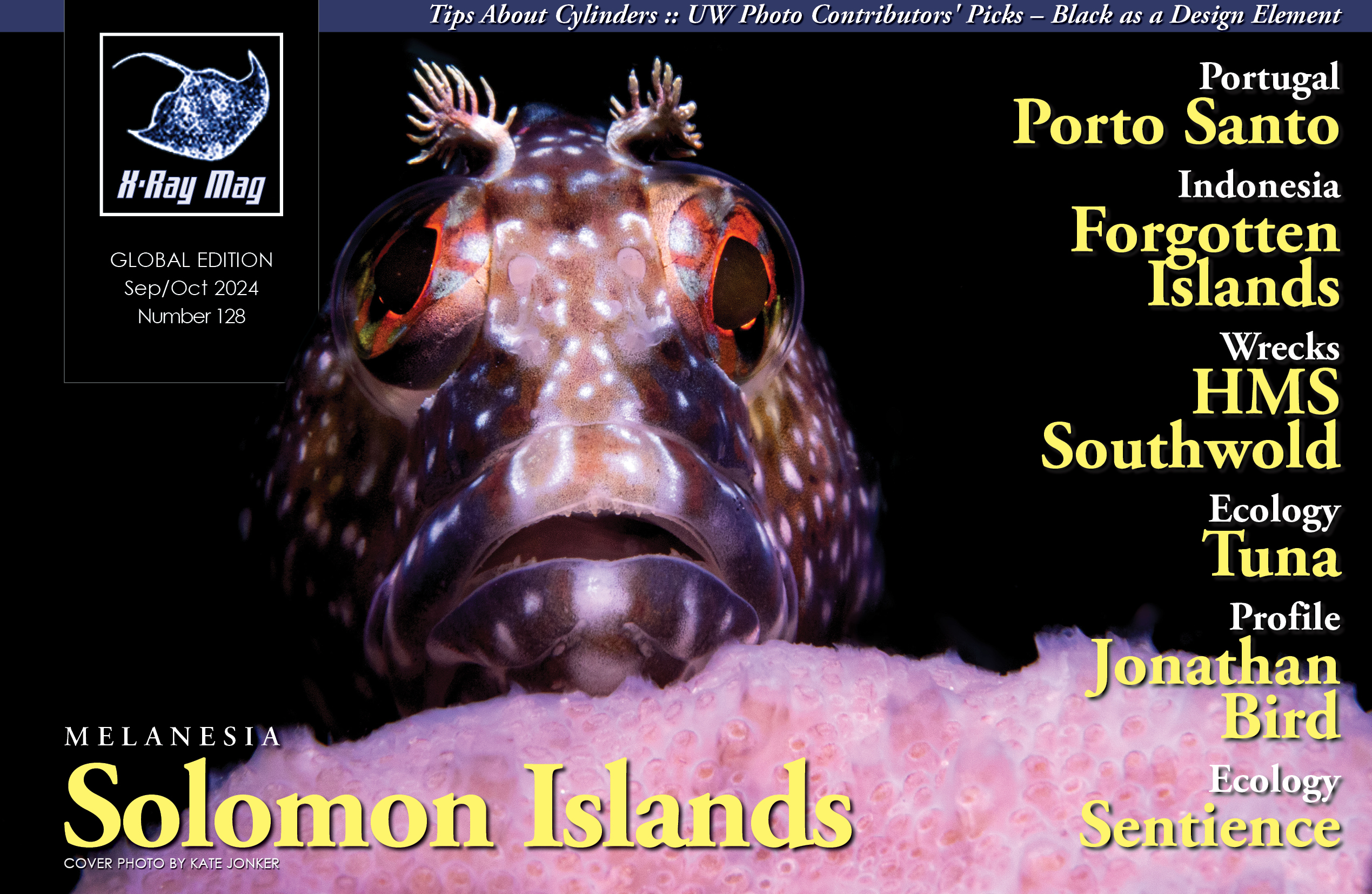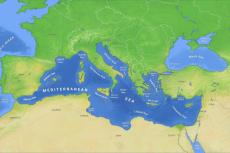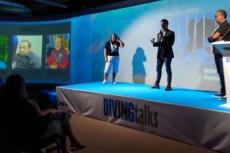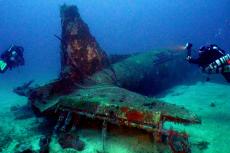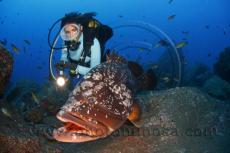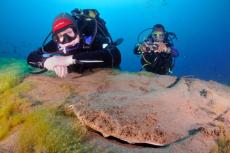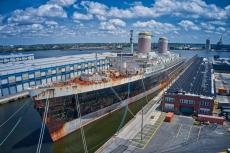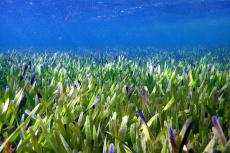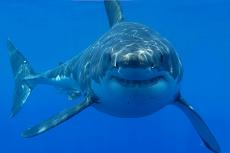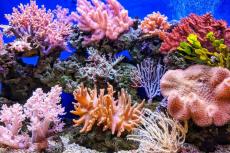Porto Santo Island, the northernmost island of the Portuguese archipelago of Madeira in the Atlantic Ocean, is known as a golden oasis with turquoise waters. There is a variety of diving to be enjoyed, from wrecks to rocky reefs with diverse marine life, as well as great food and a relaxed atmosphere. Brandi Mueller shares her adventure there.
Contributed by
Rising early to walk Porto Santo’s 5.5-mile (9km) golden sand beach, the air was cool and crisp. It was light outside, but the sun had not yet risen over the top of the island, so the beach was still draped in shadow and not too hot. The temperature was perfect for a stroll, and as I looked out over the still waters, the whole island seemed to be at peace.
Closer to Africa than Europe, the small island of Porto Santo is part of the Autonomous Region of Madeira. One of two such areas in Portugal (the other being the Azores), the region is an archipelago that also includes the island of Madeira, the Desertas and the Savage Islands. Less than seven miles (11km) long and four miles (6km) wide, the island of Porto Santo offers relaxation, great food and, most importantly, fantastic diving.
I stayed at the Hotel Torre Praia in the southwestern part of the island, which is mostly flat and where the majority of the population and hotels are located. Although the island has only around 5,000 residents, the island population grows significantly during the peak tourist season. But as I walked along the beach, it was mostly empty.
As I continued on my way, drinking in the blue skies, blue waters and golden sands, something caught my eye. There was a white rose on a rock where small waves were rolling in. As I got closer, I could see at least two dozen white roses scattered around the area. I wondered where they had come from, who they were for or if the magic of Porto Santo was perhaps welcoming me with flowers. After snapping some shots of the flowers, it was time to turn around and make my way back to the hotel to meet up with my fellow travelers on this adventure arranged by Portugal Dive. It was almost time to go diving.

Getting there
There are two ways to get to Porto Santo: by plane or by ferry. There is a short 15-minute daily flight from Madeira, and during the high season, there are a few direct flights from Lisbon. Or you can take the Porto Santo Line ferry, a 2.5-hour trip in style and comfort.
When I was told we would be taking a ferry, I pictured a smallish boat with few amenities, just a means of getting from one place to another. So, I was surprised to find something that looked more like a small cruise ship than a regular interisland ferry. Carrying over 1,000 passengers and 145 vehicles, the multi-story ship had several restaurants and bars, a cinema, a children’s play area and a lot of outdoor space and seating options. With a Mediterranean monk seal as its mascot, the Porto Santo Line ferry was the most relaxing way to get to Porto Santo. And for divers, it has another advantage: you do not have to worry about your no-fly time on the way back.
We departed in the morning and said goodbye to Madeira just after the sun had come up. The island was still glowing a warm yellow in the dawn light as we pulled away and started the 42-mile (68km) trip northeast. After watching Madeira get smaller and smaller in our wake, I joined my fellow Portugal Dive travelers for coffee in the cafeteria. Just as I was finishing, Arlindo Serrão, our host, let us know that we had a special tour. He had somehow worked his “Arlindo magic” and gotten us a tour of the bridge.
As we made our way past security and offices, the door to the bridge opened for us. We met Captain Batista and his first mate, and they graciously showed us around. As Porto Santo loomed larger in front of us, I figured the captain would kick us out, back to the regular passenger area. Instead, he invited us to the bridge wing to watch him dock the ship. Like a pro, he maneuvered us seamlessly into the pier, and we departed, taking our first steps onto the lovely island of Porto Santo.

The island
There is no record of the discovery of Porto Santo before 1418, when it was accidentally discovered by Portuguese captains blown off course by a storm while exploring the African coast, but it is generally thought that the island was known much earlier. “Porto Santo” means “Holy Harbor,” so named by the sailors who were saved from the storm by the island’s safe harbor.
Soon after its discovery by the Portuguese, Porto Santo and nearby Madeira were settled. Being drier and smaller, Porto Santo had much harsher conditions than Madeira. The settlers quickly exhausted its limited resources and altered much of the original landscape for farming and living. With little water, farming was difficult, and most supplies had to come from Madeira. The ecosystem was further altered by invasive species that took a toll on the endemic and native flora and fauna. Aside from water and food issues, the island was also repeatedly attacked by pirates, French privateers and other bandits, making Porto Santo a rather difficult place to live.
Famously, Christopher Columbus lived on the island for a few years and married the daughter of Bartolomeu Perestrelo, the island’s first donatary. A donatary was a noble person who was given a large piece of Portuguese land, in this case, the island, and essentially served as its governor. What is thought to have been Columbus’ home during this time is now a museum about his life and time there, including a more comprehensive history of Porto Santo.

Corveta Pereira D’ Eça
Loading into an inflatable skiff in a picturesque harbor close to the Porto Santo Sub dive shop, we soon headed out to open water and our first dive site, the Corveta wreck. Intentionally sunk in 2016, the Madeira Natural Park Authority coordinated contractors to prepare and sink the ship in hopes of creating an artificial reef to attract marine life and divers.
Underwater, we were met with crystal clear conditions and a lovely ship sitting upright in the sand. The water temperature was around 68°F (20°C), and the ship, which was still very much intact, had the anchor chains out in front of it, extending down to the sand with the guns pointing up to the surface. Schools of fish were all around, showing how artificially sunk wrecks make great homes for marine life.
We made our way to the stern, and before we got there, we were met by a resident dusky grouper. It allowed us to get very close for photos. I then followed José Ricardo, our dive guide and one of the owners of Porto Santo Sub, into the interior of the ship.

Having been cleaned up for divers prior to its sinking, this wreck had some great swim-throughs and penetrations that were far safer to explore than those of a ship that had sunk naturally, with all its hazards. While divers should still have adequate training and experience before entering any overhead environment, the ship had been cleared of stray wires and entanglement hazards, leaving large open spaces.
José showed me the engine room, and we worked our way through the interior of the ship. Phones were still mounted on the walls, and the bridge was easily accessible, with lots of light coming through the openings that used to be windows. It was fun to explore the inside of the wreck, and there were always lots of places with open areas and light where you could swim out if you needed to.
For our second dive, we went closer to the island and jumped in on a shallow rocky area. There was an octopus putting on a show, flashing colors, and it had its entire body out in the open. José pointed out an eel in a rock crevasse, and I positioned my camera to take a shot that I could not see. When I brought my camera back, I looked at the result, and there was not just one, but three eels in the hole. I took a few more shots and continued on, swimming right over a stingray before heading back to the boat.

The whole package
I love diving and am happy to suffer through some pretty dismal conditions in order to get underwater, but Porto Santo was the exact opposite of that. From breakfast all the way to leisurely late-night dinners, there was no going on a diet on this trip. Our resort had an excellent restaurant, but we also ventured into town and found ourselves at Tabua Rasa, a wine bar with a fantastic charcuterie board. We enjoyed local cheeses, meats and other snacks, complemented by cocktails as the sun went down. We had engaging conversations about the wreck we had just dived, the octopus and how great the visibility was.

Europe’s best beach
Porto Santo’s 5.5-mile (9km) beach has been named the best beach in Europe for many years in a row, and I made a habit of waking up early most mornings, grabbing a coffee and heading out to go for a walk on the beach.
The sand has a unique deep yellow color, almost golden, due to a mineral called calcareous. Formed by ancient coral reefs and marine organisms, this type of limestone has eroded away from the northern parts of the island, creating a stunning soft sand beach that seems to glow in the sunlight. The sand, along with the island’s perfect Mediterranean climate, is said to have healing properties and can alleviate arthritis and rheumatism.
I was still struck by how few others were on the beach. It was May and only the beginning of the tourist season, but I still expected more people. As I walked, there would be groups of people as I got closer to the hotels and resorts, but in between, the beach would empty out again, often as if I were walking on my own private golden sand beach.
One morning, I reached a spot where the beach ended and the sand turned into rocky cliffs. There was a restaurant at the point, and I could not help but have a coffee and look out over the edge of the island. Another islet, Cal, was close by, jutting out of the blue water with a mixture of dark rock and green foliage. To my right, the soft yellow sand abruptly gave way to jagged, dark gray rocky cliffs that would be a proper climb to get around. I wished I had brought my drone but settled for some photos taken from the ground. The walk was so enjoyable that I decided to do it again the next morning with the drone in tow.
Back at the hotel, I prepared my camera and dive gear, had lunch and then met our transport to Porto Santo Sub for more diving that afternoon.

The Madeirense
Our next wreck dive was the Madeirense. Arlindo had told me that the corvette was a playground for divers, but the Madeirense felt like a real shipwreck. Another short and easy skiff ride from the harbor, we were quickly moored and kitted up. The sun was shining, and there was not a cloud in the sky as we back-rolled into the crisp water.
With all divers accounted for and okay signs given, we descended along a line, and it was not long before the shadow of a ship came into focus. The visibility was epic, and soon, I could see the bow all the way to midships. I also noticed that the bow was moving… well, the bow was not moving, but it seemed to be moving, with a cloud of fish. As I got closer, ornate wrasse by the hundreds were crowding around the bow, with Atlantic chromis mixed in.
The ornate wrasse is a beautiful fish that looks like it was painted by a child. Its head is blue with red splotches, its body is green but with a blue and red vertical stripe and its fins are outlined in blue. Around six inches (~15cm) long, these fast-moving wrasses flashed color like a splatter painting, and the copper-gold bodies of the chromis made the ship look like an art installation.
After stopping to photograph the wrasse, we started swimming toward the stern. The ship was about 110ft (34m) in the sand, and we could easily see all the way to the bottom. I was able to swim away from the wreck and shoot big, wide-angle images of huge parts of the ship due to the clear conditions.
Sunk as an artificial reef in 2000, the Madeirense is a good example of how artificial reefs provide a place for fish and marine life to aggregate, and a way to generate economic growth for a location by promoting the artificial reef to divers around the world. It is a fantastic dive, and I think a diver could do many dives on it before seeing it all.

Land adventure
On our last day, we took a jeep tour around the island with Dunas Travel. I had been to the beach, and we had dived on the south side of the island, but we had yet to see the rugged cliffs of the north side. First, we headed west to the overlook at Ponta da Canaveira for a stunning view of Liheu de Ferro; it was even clear enough to see the island of Madeira, 65km (~40mi) away.
Driving northeast, the geology of the island changed drastically. Porto Santo is completely different from Madeira in terms of landscape and climate. Even though the islands are so close, Porto Santo is much more arid and home to a small patch of dunes. We went off-roading in an area of sand with sandstone rock formations, and our guide stopped to show us fossils of ancient marine creatures. This sandstone erodes and becomes the glorious yellow sand of Porto Santo’s beautiful beach.
We also stopped to see the Organ Pipes—volcanic basalt columns that look as if they were carved by machines. The site reminded me of a spot in Hawaii where lava created the same spectacle millions of years ago.
Our next stop was a quick tour of Quinta das Palmeiras, a mini-zoo and botanical garden in the middle of the desert island. There were many types of birds. One cockatoo even greeted us with an “Ola.”
As we continued, the jeep climbed in altitude, giving us stunning views of sheer cliffs and the ocean stretching as far as the eye could see. One interesting stop was at Casa da Serra, a typical settler’s house in Porto Santo. With a mini museum set up inside the house, we looked around at the antiques and ended the tour by sampling homemade poncha, a flavored rum beverage that burned a little bit on the way down.
Funny enough, one of the neatest things I saw was a hole in the ground. In the early days of settlement in Porto Santo, pirates were a serious problem. Holes were often dug and covered to hide goods and even women and children when the pirates attacked. I only hope that someone was left after the attacks to free the children hiding in the holes.

After our tour, the day got even better. José and Joana from Porto Santo Sub kindly offered to cook us lunch before our ferry departed. We arrived at the dive shop to find José with a massive splayed-open tuna, caught just hours before, ready to be cooked in a drum that had been modified into a grill. But this was just the beginning. Inside, a table was set with bread, cheese, olives, salad, vegetables and, shortly after, the absolutely delicious fish. It was such a nice gesture after all their diving hospitality, and we had such a lovely time talking. We heard more about diving around Porto Santo and how José and Joana found their way to owning a dive shop there.
Before we knew it, it was time to catch our ferry. As the sun set, we were underway, with Madeira in the distance and Porto Santo fading away behind us. Sipping drinks, we were all relaxed in that travel-weary manner where you feel like all the conversations have been had and there is nothing left to do but reminisce in silence, each of us scrolling through images taken the previous week, trying to remember all we had seen and done.
I was determined to get to bed early, as my flight was before dawn. But somehow, as we were checking back into the Sé Boutique Hotel on Madeira, I heard that dinner was still being served for another 15 minutes. I knew I would not be around food this good for a while. So, after dropping off my bags, I met some of the group at a table on a cobblestone street, and we enjoyed one last fantastic meal together, paired with local gin and Madeira wine.
Morning came, and it was back to Lisbon and onward to the west for me. As I started to edit photos on the long flight home, I found myself once again in awe of this beautiful island of Portugal and wondering when I might return. ■
Special thanks go to Portugal Dive, Visit Madeira and Porto Santo Sub.
Reference: wikipedia.org



